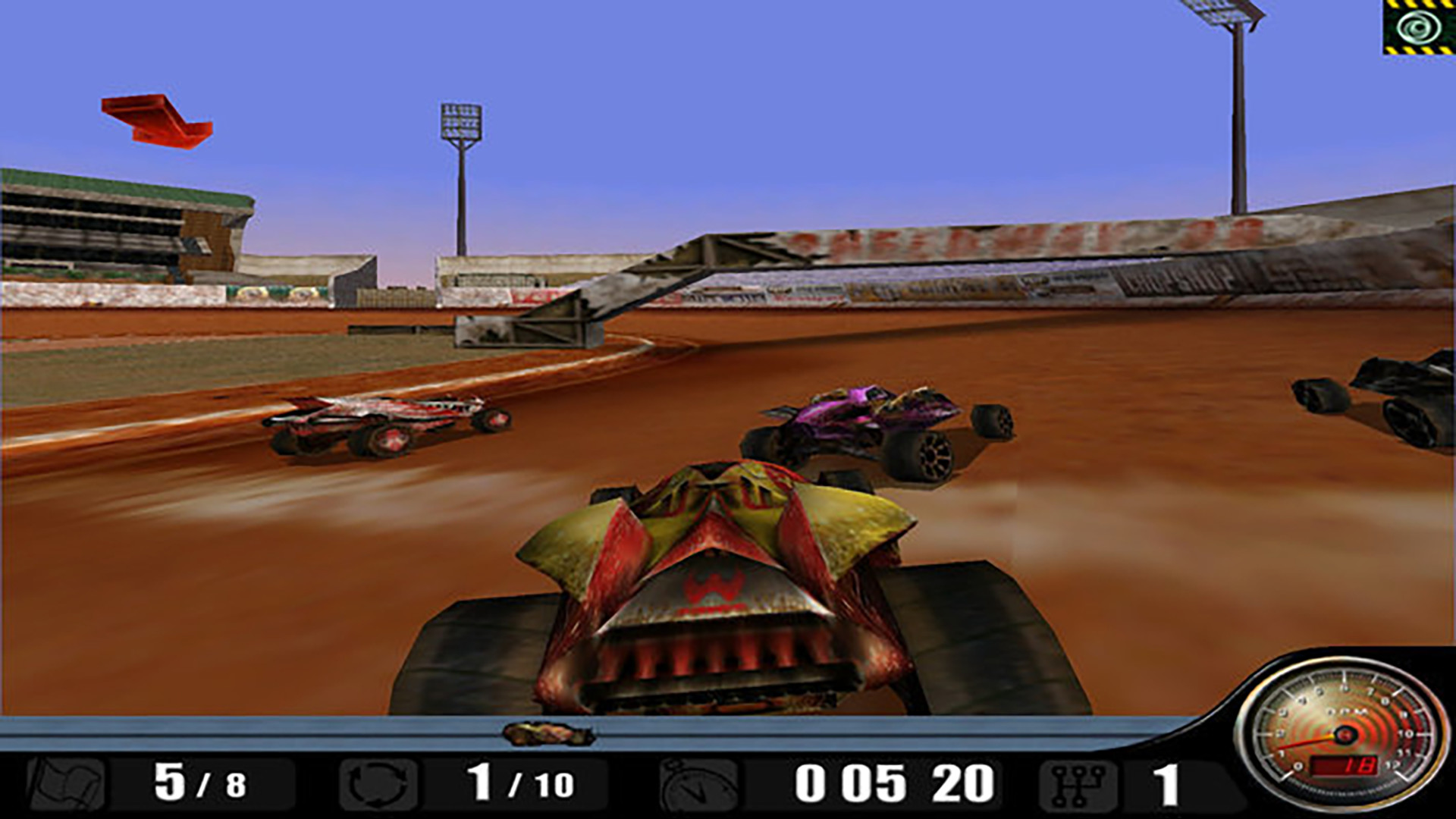Hidden Gems of Game Design Volume 16
Unearthing gems with Gloom, En Garde!, Chroma Squad, Jackal, Beyblade G-Revolution, and Powerslide

There are plenty of amazing games that go unnoticed and are not played widely, for one reason or another. Maybe it's a diamond in the rough, or the marketing wasn't there, or it could be a game ahead of its time. For this monthly series, I've asked my fellow writers on SUPERJUMP to pick a game they think is deserving of a chance in the spotlight. Let us know your favorite hidden gems in the comments.
Josh Bycer
Gloom (2017)

For my hidden gem this month, it’s a very little-known game that manages to do a whole lot with minimalistic gameplay and aesthetic. Gloom is an action roguelike that features elements of souls-like storytelling and structure. A kingdom has been put into a curse with everyone trapped in what is known as the common dream. In order to save his family, the king enters the dream and must descend into its many layers and defeat its nightmares.
The combat is more on the soulslike side as the player must manage their stamina for attacking and dodging while fighting enemies coming from all sides. Each one of the biomes has several different bosses that can show up at the end. There are three different endings that require specific conditions to unlock, and the player being lucky enough to have a chance to survive.
Due to the game taking place in 2D, combat itself is not as deep as any 3D souls-like, but the developer compensated by having a greater focus on bullet-hell. Some of the later bosses can fill the screen with death that you must dodge around to survive.
I also enjoyed the story and it is one of the few times for me that the minimalist focus worked. Gloom is by no means a long game, if you’re good at souls-likes, there’s probably around 3-5 hours of content total. But that also means you’re not given an entire department store’s worth of items and things to look through in order to piece together what happened.

What can hurt the game is that it is very luck-dependent despite the challenging combat and fights. Everyone agrees that if you want a chance at going for the harder endings and battles, you need the power known as Lifesteal, and if you’re not able to get a viable source during your run, your chance at victory will be drastically cut. There are a lot of items and passives you can find, and the differences between the good and bad ones are massive. While your skill will matter, the sheer ferocity and threat of the later bosses can be very difficult without some of the better items.
Now for some unfortunate bad news. The developer did release a game after Gloom and then started working on a sequel. However, the last update from them talked about hitting a wall and not wanting to continue development for the foreseeable future. I do hope that the designer is doing well and that things are going better for them. For now, Gloom remains a very solid slice of soulslike design that’s worth a good sleep.
CJ Wilson
En Garde! (2023)

For my hidden gem, I thought I would cover a recent game that hasn’t been getting enough exposure with enough swashbuckling antics and free-flowing combat that would make the average adventurer nod in approval. En Garde! is an action-adventure game with minimal platforming segments that provides some challenging sword combat within its intricate arenas. You play as Adalia de Volador, a dashing hero of the people who helps out the poor, looks for thrills and excitement, and seeks to foil conspiracies and discover hidden treasure along the way.
Throughout the four-story episodes that the game includes, Adalia runs into some colorful characters like her brother Alejandro, a playwright who strives to be a folk hero like her sister by assuming the role of El Vigilante, and Zaida, a sharp-witted thief whom Adalia seems to share feelings with. But there is also the diabolical Count-Duke who seeks unlimited power while ruling a coastal Spanish city that Adalia resides in with an iron fist.
Much of the combat revolves around your rapier that you use to take out enemies that surround your position. Ideally, you shouldn’t attack multiple guards at once since you can get overwhelmed very easily. So what you need to do is use the environment to your advantage by grabbing various objects around you like buckets and lanterns that you can use to distract and stun the enemies off balance allowing openings for you to attack. Performing these stylish moves increases your panache meter which gives you unique attacks that can eliminate the competition.
As you focus on an enemy, you will need to time your sword strikes with dodges and parries in order to succeed. Certain color indicators from the enemies’s strikes will make the difference with red meaning you have to dodge, blue allowing you to parry with a counter-slash, and white giving you a choice to either attack or dodge. As you are moving around these elaborate arenas, you can perform some flourishes like performing a somersault or dropping a chandelier to surprise your foes which gives you an opening to attack straight away.

The gorgeous painted locations like the towns, private villas, and lush islands that you explore in between the combat sections. It’s not a long game either as you will easily breeze through the story chapters in about 4-5 hours. You can replay these sections to find points of interest that flesh out the lore, discover hidden areas, and earn additional achievements as well.
You can also unlock an arena mode with different skill levels that offers randomized modifiers, both positive and negative, as you go through increasingly challenging waves of enemies.
En Garde! is not a perfect game as there are occasional glitches like enemies getting stuck in the level geometry and the camera not always keeping track of Adelia as you struggle to judge your strikes against aggressive types of adversaries like duelists and captains with unblockable hits. But regardless of these issues, the humorous banter and playful mechanics make En Garde! a title worthy of an adventure worth remembering with fights filled with spectacle and a story full of heart and emotion worth rooting for.
Andrew Johnston
Chroma Squad (2015)

TRPG fans are really spoiled for choice these days, but that boom is a recent phenomenon. It wasn't that long ago that the TRPG was a tiny, underexplored subgenre forever lost in the shadow cast by Final Fantasy Tactics. Chroma Squad was one of the first games of that boom, and it remains one of the more interesting and novel games in the category.
Chroma Squad begins as the story of a TV show. A group of stunt actors, fed up with the dictates of their tyrannical director, break away and start a nil-budget tokusatsu show of their own. After some early successes and struggles (including threats from the director), they attract the attention of a mysterious benefactor. The show takes off in a big way under his assistance, but it also starts to become disturbingly real. Eventually, the actors find themselves becoming real heroes, enlisted in the fight against an invading alien army.
The core gameplay is pretty standard to the subgenre but with a few novel twists. The five characters can be divided into MOBA-like archetypes (tank, damage, flanker, healer, support) that are easy to understand. They can work together during a fight, boosting each other into theatrical, movement-extending flips or combining to deliver a boss-killing super attack. There's no experience - Chroma Squad is an early example of a level-free RPG, with the entire party gaining access to new abilities at plot important moments.

Because Chroma Squad is framed as a show, the levels are broken down into seasons, episodes, and scenes. However, it's not enough to just plow through those episodes - if one wants to make it to the next season, it's necessary to play with some panache. The team gains followers as they complete levels. These followers are used to make money that's used to upgrade the set and props, but a certain number of followers are also needed to unlock each season finale. The player gains followers by executing team attacks and completing side objectives within scenes and loses them when an actor goes down or they botch a scene, which adds a new dimension: It's not enough to win, one has to win well.
Chroma Squad is certainly a rough experience - there are balance issues, the plot skips over some interesting potential stories to focus on a fairly bland spec story, and the daikaiju scenes used to break up the gameplay aren't much fun. But in spite of this, the novel setting and creative mechanics make Chroma Squad much more memorable than some more polished TRPGs that are "spiritual successors" trying to copy someone else.
Geordi Ferguson
Jackal (1998)
Back in the late '80s and '90s, Konami was releasing back-to-back hits at the arcade and at home. One unsung hero of these years is the NES game, "Jackal".
The set-up is delightfully pulpy and of the era. Infrared satellites have picked up American prisoners of war still trapped on enemy soil along the fringes of the Cambodian border. Rather than mounting an invasion and risking an all-out war, the President turns to the Green Berets and their tactical "Jeep Squad" to infiltrate. Code Name - Jackal!
The four taking on this covert yet loud mission are Sgt. Quint, an ex-Indy car driver turned mercenary, riding with Lt. Bob, the finest sharpshooter in history. In the other jeep is Col. Deckar, Commander and Medal of Honor recipient, who shoots for Cpl. Grey, the winner of six European Grand Prix races, who is considered the greatest stunt driver since Evil Bo Weivel (not a typo). This set-up alone deserves multiple titles.
The goal is to move forward into enemy territory, blasting open buildings with hostages and dropping them off safely at the chopper.
Jackal controls like a dream, with 8-direction movement, perfect for running down enemy soldiers. While your heavy artillery fires in the direction the jeep is facing, the machine gun only ever fires upwards. It's a small feature that adds strategy when approaching enemies and their encampments and gives the game a constant sense of momentum. Furthermore, the screen prevents backtracking very much making retreat not a viable option. The only rule of engagement for the Jeep Squad is forward!

Jackal has a perfect handle on the limitations of the NES keeping it a polished experience. The limited palette of the NES is used fully to craft diverse locations avoiding the drab style of many military shooters of the time. These all have unique traits like swamps that slow movement, crumbling ruin debris, and traps. It keeps to its processing limit and avoids slowing down by making encounters strategic and more meaningful rather than throwing an absurd amount at you. Lastly, pushing the sound chip, the composition of the music is incredibly striking, full of heroics and danger.
What brings all of this home is the wonderful co-op experience that has made Jackal an enduring memory for so many fans. A Sunday of retro co-op action with a friend, spouse, or child can always use more Jackal.
Antony Terence
Beyblade G-Revolution (2004)
I don’t remember the Beyblades I’ve owned. But I fondly remember a certain Beyblade game on Nintendo’s Gameboy: Beyblade G-Revolution from 2004. Few things can replace the tactile feeling of using a ripcord and launcher to send a chunky Beyblade spinning. But being able to control a Beyblade and switch between attacks and blocks gave me a degree of control that a physical toy couldn’t offer.
Just like the popular toys, you “let it rip” with a ripcord and launcher in the Gameboy to send your Beyblade into a virtual arena. While there are some mild RPG elements that involve consuming items to raise in-game stats, gameplay primarily focuses on Beyblade duels. Beyblade G-Revolution tasks you with winning the BBA (Beyblade Battle Association) tournament.
Instead of health, the title displays your spinning RPM (rotations per minute). Since you and your foe are on the clock, you have to slow the opponent’s Beyblade down before yours stops spinning. Each Beyblade has its own sense of weight and has unique combos to trigger. Holding down your attack or defense buttons powers them up but you’ll have to watch out for enemy countermeasures. Dodges and jumps are particularly satisfying when you successfully evade an attack.
Win and you add the enemy’s Beyblade to your collection, ready to be leveled up. Lose and you give away your Beyblade. Lose enough times in a row and you lose most of your collection. While you can purchase more, leveling a Beyblade up all over again is a harrowing prospect. As a kid, it took me a while to understand that winning against rivals opened up new portions of the map, pushing the storyline forward. After challenging every stranger in the park, G-Revolution’s Pokémon-like world map began to grow.

You can customize Beyblades to improve their stats, making for some sweet custom builds with strengths and weaknesses. Repairing your ripcords, launchers, and Beyblades also forms a part of this loop. I wonder how the internet would change things now, with easy-to-access guides for the best Beyblade builds. While the story itself is pretty thin, a Persona-like social link system would have done wonders to keep things interesting outside combat. Characters from the show make occasional appearances in the game, making this even more of a missed opportunity.
A solid battle system paired with customization options makes Beyblade G-Revolution one of the more interesting titles on the Gameboy. Letting you use Beyblades from the show made collecting them a worthy challenge for diehard fans. The only real drawback outside of the terrible soundtrack was that losing your Beyblades in Beyblade G-Revolution felt like an artificial way to pad up those gameplay hours. In turn, this made the story a chore as losses chipped away at your progress. Beyblade G-Revolution is definitely worth your time if you still have a dusty retro handheld or a legal emulator.
Gavin Annand
Powerslide (Ratbag Games, 1998)

If forced to pick an example of game design, it’s unlikely that many gamers would choose a racing game. Like sports games, racing games have always been a staple of the gaming landscape, but because they aren’t host to life-changing narratives or particularly unique mechanics, they are somewhat unfairly discounted as not being “serious” enough to warrant accolades. The racing genre is much like the comedy genre in film – a steady source of endless entertainment, but rarely a contender for the grand prize of the Oscars.
Casting aside critical bias, the fact is that racing games are popular for a reason, and occasionally, a racing game will come along that pushes the genre in impressive new directions. 1998’s Powerslide, from the now defunct South Australian studio Ratbag Games, is one of those titles.
Powerslide is a circuit racer in the classic late 90s style – a range of cars and circuit tracks, with no open-world mechanics in sight. What made Powerslide stand out from other racers of its generation, like Need for Speed, POD, and DethKarz, was the driving model. Suspension and traction on each wheel are modelled independently in the game engine, and each vehicle chassis felt uniquely weighty. Combined with some diverse tracks with multitudes of surfaces, each with differing friction coefficients, Powerslide made for a unique, white-knuckle driving experience, where the slightest error in your line could see you drop three or four places in a race.
Powerslide’s post-apocalyptic setting was a vehicle (no pun intended) for some very creative tracks too – The Dam Track’s highlight was racing up the wall of a dried-out dam, with momentum launching you into the following hairpin. Another sees you racing through an abandoned city, and my favourite track takes place on an abandoned winter luge/bobsled track – maintaining control of your vehicle down the winding half-pipe is a hair-raising challenge.

Though Powerslide was universally well received, Ratbag Games had limited success turning that into an enduring legacy. Powerslide’s impressive driving model returned for Ratbag’s niche Dirt Track Racing series in the following years. The sixth generation PlayStation 2 and Xbox should have provided Ratbag with the perfect opportunity to expand their market, but a poorly received Dukes of Hazzard game failed to live up to the changing expectations of a new generation of racing genre fans. Ratbag was acquired by Midway Games in August 2005, and a few months later, the studio was shut down.
Though Ratbag Games faded with a whimper rather than a bang, the legacy of Powerslide lives on thanks to modern distribution through GOG and Steam. This plucky cult classic is a must-play for any racing game fan. While it lacks some of the depth of features that modern racing fans have come to expect, the driving model still feels unique and exciting. Just remember – if you’re not spending 80% of your track time traveling sideways, you’re playing it wrong.




